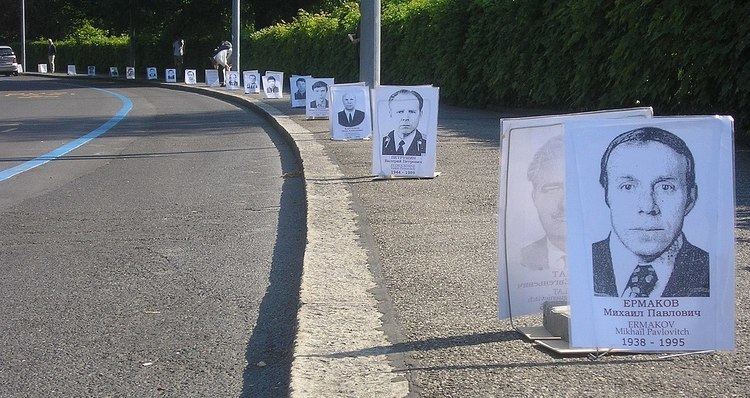 | ||
The Chernobyl disaster (Ukrainian: Чорнобильська катастрофа, Chornobylʹsʹka katastrofa, Chernobyl accident), was considered the worst nuclear disaster in history. It occurred on 26 April 1986 at the Chernobyl Nuclear Power Plant in the Ukrainian Soviet Socialist Republic, then part of the Soviet Union), now in Ukraine. The scientific consensus on the effects of the disaster has been developed by the United Nations Scientific Committee on the Effects of Atomic Radiation (UNSCEAR). In peer-reviewed publications UNSCEAR has identified 49 immediate deaths from trauma, acute radiation poisoning, a helicopter crash and cases of thyroid cancer from an original group of about 6,000 cases of thyroid cancers in the affected area A United Nations study estimates the final total of premature deaths associated with the disaster will be around 4000, mostly from an estimated 3% increase in cancers which are already common causes of death in the region.
Some non-governmental organizations, many with staunch positions on the spectrum of the nuclear power debate, have claimed numbers up to a million excess deaths caused by the nuclear disaster. UN and other international agencies such as the Chernobyl Forum and the World Health Organization state that such numbers are wildly over-estimated. The Chernobyl Forum also acknowledges an increase in psychological problems amongst those exposed to radiation, which may be attributed in part to poor communication of radiation effects and disruption to their way of life, but is also likely affected by other events surrounding the breakup of the Soviet Union.
Complicating the conflict is the fact that, with the exception of diagnoses of Acute Radiation Syndrome, obvious industrial accidents on site, and a detailed analysis of thyroid cancers among children, assignment of causes of death is a statistical rather than a deterministic process. Although non-peer-reviewed publications allege a variety of cancers, heart and other organ diseases, birth defects in children and grandchildren of nearby residents and other ailments, for the majority of these conditions radiation exposure is not even a recognized cause and, in any case, the incidence of such conditions in the relevant population has actually fallen since the Chernobyl incident. On the other hand, the effects of radiation are becoming better known as experience gathers and formerly disconnected illness may actually be the result of long-term, unseen damage during the exposure event.
During mid-1986 the official Soviet death toll rose from 2 to 31, a figure that has often been repeated. Following the disaster itself, the USSR organized an effort to stabilize and shore up the reactor area, still awash in radiation, using the efforts of 600,000 “liquidators” recruited from all over the USSR. Some organizations claim that deaths as a result of the immediate aftermath and the cleanup operation may number at least 6,000, but that exceeds the number of workers believed, by the National Committee for Radiation Protection of the Ukrainian Population, to have died from all causes (including, for example, old age and traffic accidents). The UNSCEAR report cites only evidence for thyroid cancers among children and teens (adults are quite resistant to iodine-131 poisoning) and some small amount of leukemia and eye cataracts among the most irradiated of the workers; no evidence for hard cancers has been found, despite waiting beyond the elapse of the usual ten year latency period. For further information on the indirect health implications, see Chernobyl disaster's effects on human health.
Deaths due to trauma and radiation sickness
In the list following are 38 people whose deaths are directly attributable to the Chernobyl disaster. Of these, two died at the scene, four died in a single helicopter accident, 29 died within a few months of Acute Radiation Syndrome (ARS) and three died later, perhaps from medical complications probably caused by the accident. One was a cinematographer, one a physician, five military personnel (four in a single helicopter), seven firefighters, two security guards and the rest staff at the power plant or subcontractors. At least one other person is reported to have died of a coronary thrombosis at the scene, and nine children are reported to have died of thyroid cancer (in 2005 that number was raised to 15), but identifications are not known. No members of the general public were hospitalized in the month following the accident, though a pair of fishermen, Pustavoit and Protasov, reportedly received 400 REM doses. There were a total of 137 confirmed cases of ARS, including Pyotr Palamarchuk who survived after a reported exposure to 800 roentgens, twice the usual death dose.
The following list is of those directly killed by the explosion and initial radioactivity release, or in the support efforts that followed.
